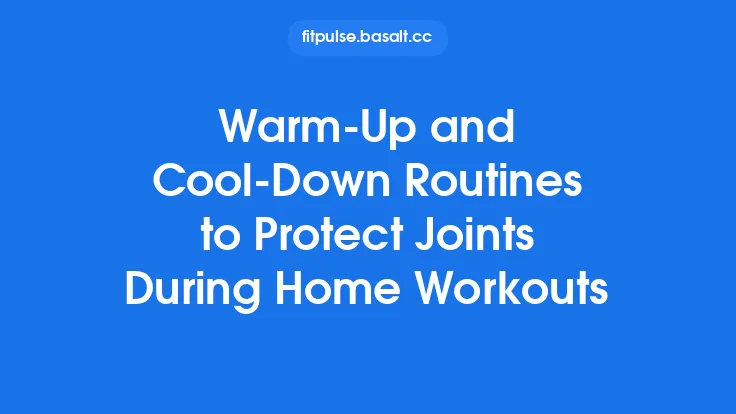High‑Intensity Interval Training (HIIT) delivers impressive cardiovascular and metabolic benefits, but the quality of each session hinges on how you prepare your body before the work intervals and how you transition out of the effort afterward. A well‑structured warm‑up primes the neuromuscular system, enhances blood flow, and reduces injury risk, while an effective cool‑down facilitates recovery, clears metabolic by‑products, and supports long‑term performance gains. Below is a comprehensive guide to optimizing HIIT performance through evidence‑based warm‑up and cool‑down protocols.
Why Warm‑Up Matters for HIIT
- Physiological Activation
- Core temperature rise: Elevating muscle temperature by 1–2 °C improves enzymatic activity, increases muscle elasticity, and speeds nerve conduction, allowing you to generate force more efficiently during high‑intensity bursts.
- Cardiovascular priming: A gradual increase in heart rate and stroke volume enhances oxygen delivery to working muscles, reducing the abrupt cardiovascular stress that can occur when jumping straight into maximal effort.
- Neuromuscular Coordination
- Dynamic movements stimulate motor unit recruitment patterns that will be used during the intervals, sharpening proprioception and timing. This is especially important for complex HIIT exercises such as kettlebell swings, plyometric jumps, or sprint drills.
- Injury Prevention
- Warm‑up improves the viscoelastic properties of tendons and ligaments, decreasing the likelihood of strains, sprains, and over‑use injuries that are more common when muscles are cold and stiff.
Structuring an Effective HIIT Warm‑Up
A warm‑up for HIIT should be progressive, specific, and time‑efficient. Aim for a total duration of 8–12 minutes, divided into three phases:
1. General Activation (2–3 minutes)
- Low‑intensity cardio: Light jogging, brisk walking, or a low‑resistance bike at 40–50 % of your estimated maximal heart rate.
- Goal: Raise core temperature and increase blood flow without causing fatigue.
2. Dynamic Mobility (3–4 minutes)
Focus on joint ranges of motion that mirror the upcoming HIIT movements. Perform each exercise for 30–45 seconds, moving continuously.
| Target Area | Dynamic Exercise | Key Benefits |
|---|---|---|
| Ankles & calves | Heel‑to‑toe walks, ankle circles | Improves dorsiflexion for sprinting or jump landings |
| Hips & glutes | Walking lunges with torso twist, lateral leg swings | Prepares hip extensors for squat‑based intervals |
| Knees & quadriceps | High‑knee march, knee‑to‑chest walks | Enhances knee stability and quad activation |
| Core & spine | Torso rotations, inchworms, cat‑cow stretch | Engages core stabilizers for plank‑type intervals |
| Shoulders & upper back | Arm circles, band pull‑aparts, scapular push‑ups | Readies shoulder girdle for push‑press or rowing intervals |
3. Specific Activation (3–5 minutes)
Transition to movements that closely replicate the intensity and pattern of the HIIT work intervals, but at a reduced load or speed.
- Example for a sprint‑based HIIT: 2 × 30‑second “strides” at 60 % effort, focusing on proper running mechanics.
- Example for a bodyweight circuit: 1 set of 10–12 air squats, 8–10 push‑ups, and 10–12 mountain climbers performed at a controlled tempo.
- Example for kettlebell HIIT: 1–2 minutes of kettlebell dead‑lifts or goblet squats at 40 % of the working load.
Key principle: The specific activation should not induce fatigue; it merely rehearses the movement pattern and primes the central nervous system.
Monitoring Warm‑Up Intensity
- Heart Rate: Aim for 50–65 % of your estimated HRmax (220 – age).
- Perceived Exertion: Target a Borg RPE of 3–4 (light to moderate).
- Breathing: You should be able to hold a conversation comfortably.
If you notice excessive breathlessness or a rapid rise in heart rate, reduce the intensity or extend the general activation phase.
Why Cool‑Down Is Essential After HIIT
- Gradual Cardiovascular Recovery
- Abrupt cessation of high‑intensity work can cause blood to pool in the extremities, leading to dizziness or faintness. A cool‑down allows heart rate and blood pressure to normalize safely.
- Metabolic Clearance
- HIIT generates lactate, hydrogen ions, and other metabolic by‑products. Low‑intensity activity promotes circulation, facilitating their removal and reducing post‑exercise muscle soreness.
- Restoration of Muscle Length
- Intense contractions can shorten muscle fibers. Gentle stretching during the cool‑down helps restore optimal resting length, preserving flexibility and reducing tightness.
- Hormonal Balance
- A gradual transition supports the shift from sympathetic (fight‑or‑flight) dominance back to parasympathetic (rest‑and‑digest) activity, aiding recovery and sleep quality.
Designing a Structured Cool‑Down
A cool‑down should last 5–10 minutes, comprising two components: active recovery and static stretching.
1. Active Recovery (3–5 minutes)
- Low‑intensity cardio: Slow jog, walk, or easy cycling at 30–40 % HRmax.
- Purpose: Maintain gentle blood flow while allowing heart rate to decline gradually.
2. Static Stretching (2–5 minutes)
Target the primary muscle groups engaged during the HIIT session. Hold each stretch for 20–30 seconds, breathing deeply, and repeat once if needed.
| Muscle Group | Stretch | Technique |
|---|---|---|
| Quadriceps | Standing quad stretch | Pull heel toward glutes, keep knees aligned |
| Hamstrings | Seated forward fold | Hinge at hips, keep spine neutral |
| Glutes & Hip Flexors | Figure‑four stretch | Cross ankle over opposite knee, gently press down |
| Calves | Wall calf stretch | Press forefoot against wall, lean forward |
| Chest & Shoulders | Doorway pec stretch | Place forearm on doorframe, step forward |
| Upper Back | Child’s pose | Kneel, sit back on heels, extend arms forward |
Tip: If you experience any lingering tightness, extend the stretch duration or incorporate foam‑rolling for additional myofascial release.
Integrating Warm‑Up and Cool‑Down Into Your HIIT Schedule
- Consistency: Treat warm‑up and cool‑down as non‑negotiable parts of every HIIT session, just like the work intervals themselves.
- Time Management: If you’re short on time, prioritize a 5‑minute dynamic warm‑up and a 3‑minute active cool‑down; you can add static stretches on rest days.
- Periodization: During higher‑volume weeks (e.g., 4–5 HIIT sessions), consider extending the cool‑down to 7–10 minutes to aid recovery. Conversely, on lighter weeks, a shorter warm‑up may suffice.
Special Considerations
Age‑Related Adjustments
- Older adults may benefit from a slightly longer general activation (4–5 minutes) and more emphasis on joint mobility drills to counteract age‑related stiffness.
Injury History
- Previous ankle or knee issues: Incorporate ankle‑stability drills (e.g., single‑leg balance, mini‑band eversion) into the dynamic mobility phase.
- Shoulder problems: Add rotator‑cuff activation (e.g., external rotations with a light band) before upper‑body HIIT movements.
Environmental Factors
- Cold environments: Extend the general activation by 1–2 minutes and consider adding a light layer that can be removed once core temperature rises.
- Hot/humid conditions: Keep the warm‑up slightly shorter to avoid excessive early sweating, but ensure adequate hydration before starting.
Sample Warm‑Up & Cool‑Down Protocols
A. Sprint‑Focused HIIT (30 seconds sprint, 30 seconds rest, 8 rounds)
Warm‑Up (10 min)
- 3 min light jog (50 % HRmax)
- Dynamic mobility:
- Walking lunges with torso twist – 45 sec
- High‑knee march – 45 sec
- Ankle circles – 30 sec each foot
- Specific activation:
- 2 × 30‑sec strides at 60 % effort, focusing on arm swing and foot strike
Cool‑Down (7 min)
- 4 min easy jog/walk, gradually slowing pace
- Static stretches:
- Standing quad stretch – 30 sec each side
- Hip flexor stretch – 30 sec each side
- Calf wall stretch – 30 sec each side
B. Bodyweight Circuit HIIT (45 seconds work, 15 seconds rest, 10 rounds)
Warm‑Up (9 min)
- 2 min brisk walk or low‑resistance bike
- Dynamic mobility:
- Arm circles – 30 sec forward/backward
- Inchworms – 45 sec
- Lateral leg swings – 30 sec each side
- Specific activation:
- 10 air squats, 8 push‑ups, 10 mountain climbers at a controlled tempo
Cool‑Down (5 min)
- 2 min slow marching in place, deep breathing
- Static stretches:
- Child’s pose – 30 sec
- Figure‑four stretch – 30 sec each side
- Chest doorway stretch – 30 sec each side
Frequently Asked Questions
Q: Can I skip the warm‑up if I’m already “warmed up” from daily activity?
A: Even if you feel warm, a targeted warm‑up ensures the specific muscles and neural pathways used in HIIT are primed. Skipping it increases the risk of sub‑optimal performance and injury.
Q: Is static stretching better than dynamic stretching before HIIT?
A: Dynamic stretching is superior pre‑HIIT because it maintains muscle temperature and improves range of motion without reducing power output. Static stretching is best saved for the post‑session cool‑down.
Q: How long should my heart rate stay elevated after a HIIT session?
A: A gradual decline is ideal. Aim for a 5‑minute active cool‑down that brings heart rate down to roughly 60 % of HRmax before stopping. This helps prevent post‑exercise hypotension.
Q: Should I incorporate foam‑rolling into the warm‑up?
A: Light foam‑rolling can be useful for particularly tight areas, but keep it brief (≤1 minute per muscle group) to avoid excessive fatigue before the high‑intensity work.
Bottom Line
Optimizing HIIT performance isn’t just about the work intervals; it’s equally about how you enter and exit each session. A structured warm‑up elevates core temperature, activates the nervous system, and safeguards joints, while a purposeful cool‑down accelerates recovery, clears metabolic waste, and preserves flexibility. By integrating the progressive warm‑up and cool‑down protocols outlined above into every HIIT workout, you’ll experience smoother transitions, reduced injury risk, and sustained performance improvements—making each high‑intensity effort more effective and enjoyable.





